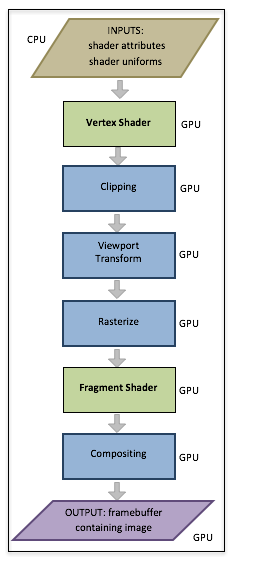9.7 - Summary¶
This lesson puts transformations (chapters 6), cameras (chapter 7) and projections (chapter 9) into perspective (no pun intended)!
A Review of the Graphics Pipeline¶

The Graphics Pipeline
To understand computer graphics you must understand the graphics pipeline. Let’s review the graphics pipeline again.
You have a set of models that define a virtual scene. The models contain two basic types of data:
- Geometric data composed of vertices,
(x,y,z), and normal vectors,<dx,dy,dz>, and - Material properties data such as colors, texture coordinates, shininess coefficients, etc..
This data is passed through the graphics pipeline to create a 2D image of the scene. The first stage of the pipeline deals with the geometry data in a vertex shader, while a fragment shader deals with the material properties data.
In the first stage (a vertex shader program):
- The geometric data is transformed using a 4-by-4 transformation matrix to place the geometry of the model in its desired location, orientation, and size. This is referred to as the “model transform.”
- The geometric data is transformed using a 4-by-4 transformation matrix to place the scene in front of a virtual camera. This is referred to as the “camera transform” (or the “view transform”).
- The geometric data is projected onto a 2x2x2 clipping volume, the front face of which defines a 2D viewing window. This is referred to as the “projection transform.”
All of these transformations happen in a vertex shader program. You create the required transformation matrices in a JavaScript program and a vertex shader program executing on a GPU performs the actual geometric data transformations. Most WebGL programs combine all of these transformations into a single 4-by-4 transformation matrix. The ordering of the transformation matrices from right to left is critical because the model transformation must happen first, then the camera transformation and finally the projection transformation. In matrix format, your JavaScript program creates:
=ProjectionMatrix
*CameraMatrix
*ModelMatrix
Eq1
This single transformation transforms a scene’s geometry data into a clipping volume – a 2x2x2 cube centered at the origin. All geometry outside this cube is clipped away. Then the pipeline begins to create a 2D image by mapped the vertices into a 2D array of pixels. This is referred to as the “viewport transform.”
The geometry data is now positioned in the correct place inside a 2D image. However, all of these transformations have only been done on the vertices of the points, lines and triangles. All of the pixels that compose a primitive object have not been determined. That is the next step in the pipeline and it is called the “rasterize” stage.
Rasterize¶
To rasterize means to convert vector based descriptions of a geometric object into a set of pixels. For example, if we know the pixel locations of three vertices that define a triangle, to rasterize the triangle means we determine which pixels lie inside the boundaries formed by the triangle’s vertices and edges. The rasterize stage of the pipeline is done automatically.
For each pixel that is used to compose a primitive object, a “fragment” is created. A fragment knows its pixel location and other information that might be needed to assign the pixel a color value. Each “fragment” that is created is passed through a fragment shader executing on the GPU. A fragment shader program performs calculations that assign an appropriate color to its pixel.
The next two chapters explain how a fragment shader calculates the color of a pixel.
Glossary¶
- rasterize
- Convert a vector based description of a geometric object into a set of pixels.
- fragment
- A group of values related to an individual pixel in an image.
- fragment shader
- A computer program, written in GLSL, that calculates a color for a pixel using information contained in a fragment.